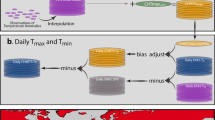Summary
A high-resolution objective analysis has been applied to conventional and satellite retrieved temperature profiles to investigate differences among the two sets of data. The case study selected represents the first stages of a rapid cyclone development in the lee of the Alps. It is found, both in statistical and qualitative terms, that satellite data are in good agreement with conventional ones and that a detailed description of the temperature field at surface is of primary importance for an accurate retrieval of satellite soundings, particularly for use in mesoscale meteorology. The time lag between the two different data sets is found to explain a consistent portion of the discrepancies and therefore a full quadridimensional assimilation scheme appears to be essential to pursue the investigation.
Riassunto
Viene presentato uno studio comparativo di analisi ad alta risoluzione del campo di temperature ottenuto sia da dati convenzionali che da radianze misurate da satellite. La situazione meteorologica studiata è una rapida ciclogenesi nel golfo ligure. I campi ottenuti da satellite e quelli convenzionali sono in buon accordo sia in termini statistici che semi qualitativi. I risultati ottenuti indicano che una descrizione dettagliata del campo di temperatura alla superficie inferiore è di importanza primaria per ottenere profili di temperatura di elevata qualità, particolarmente se essi debbono essere utilizzati in descrizioni meteorologiche a mesoscala. La differenza temporale tra i due tipi di dati è in grado di spiegare una parte consistente delle discrepanze evidenziate, per cui l'utilizzazione di uno schema di assimilazione dati quadri-dimensionale appare essenziale per proseguire questo tipo di confronto.
Резюме
Оредлагаются результаты сравнительного анализа с высоким разрешением температурных полей, полученных из обычных данных и данных со спутника. Исследуется метеорогическя ситуация, которая представляет первые стадии разития быстрого циклона в Лигурийском заливе. Получается хорошее согласие между температурными полями из обычных данных и данных со спутника. Полученные результаты покзывают, что подробное описание температурного поля на поверхности является особенно важным для использования в среднемаштабной метеорологии. Запаздывание между двумя различными системами данных объясняет часть обнаруженных расхождений.
Similar content being viewed by others
Literatur
A. Buzzi, A. Trevisan andE. Tosi:Beitr. Phys. Atmos.,58, 273 (1985).
A. Trevisan, A. Buzzi, E. Tosi andS. Rambaldi:Nuovo Cimento C,8, 805 (1985).
W. L. Smith, H. M. Woolf, C. M. Hayden, A. J. Schreiner, andJ. M. Lemarshall:The Physical Retrieval TOVS Export Package, Technical Proceedings of the First International TOVS Study Conference, Igls, 1985.
A. Buzzi andS. Tibaldi:Q. J. R. Meteorol. Soc.,104, 271 (1978).
J. F. LeMarshall:An intercomparison of temperature and moisture fields retrieved from TIROS operational vertical sounder data, Technical Proceedings of the Second TOVS Study Conference (Igls, 1986).
R. Rizzi:Nuovo Cimento C,7, 317 (1984).
Author information
Authors and Affiliations
Rights and permissions
About this article
Cite this article
Rizzi, R., Tosi, E. Comparison of temperature fields obtained from conventional and satellite data using an high-resolution objective analysis. Il Nuovo Cimento C 11, 405–428 (1988). https://doi.org/10.1007/BF02533134
Received:
Issue Date:
DOI: https://doi.org/10.1007/BF02533134




